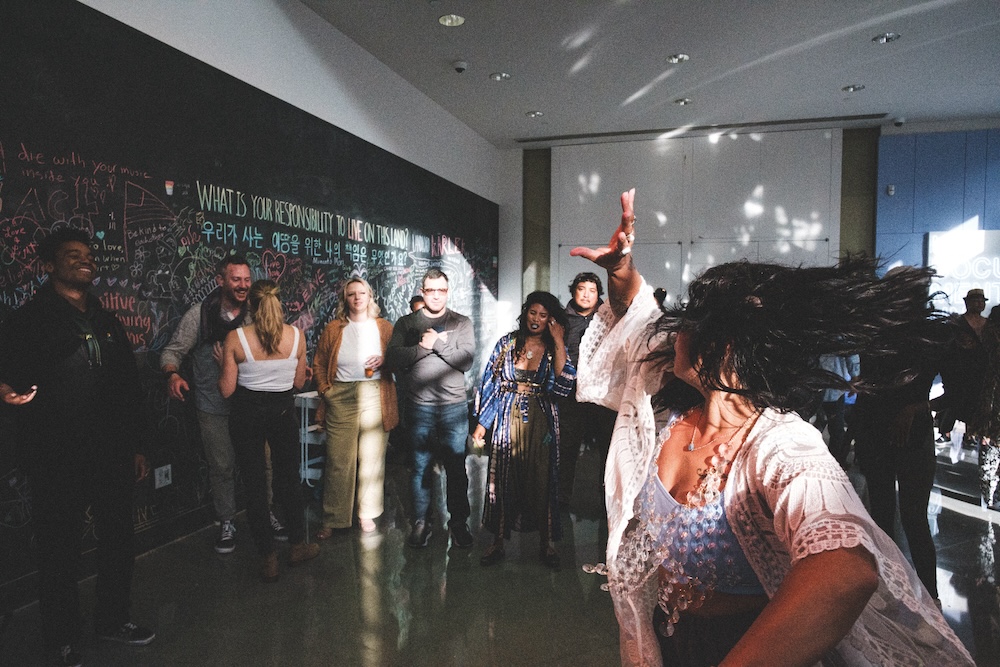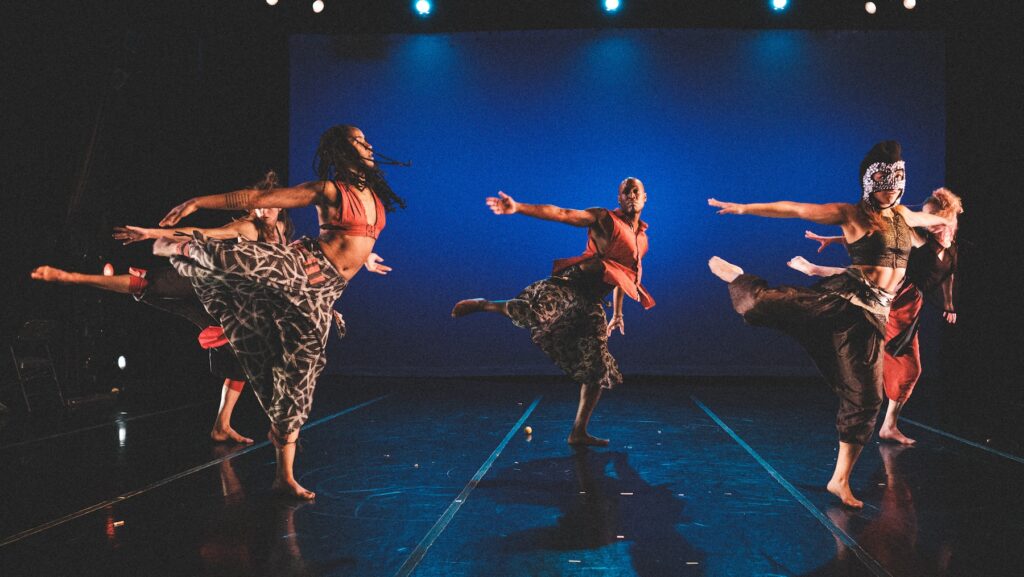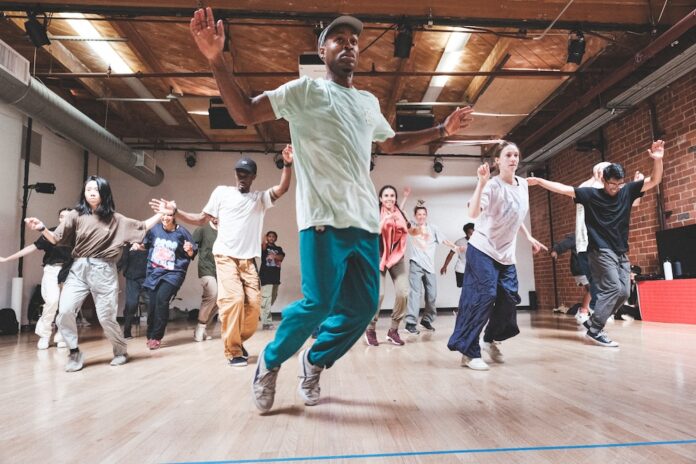The annual Get Free Festival (Fri/28-July 6 at various SF venues), celebrating its fifth incarnation under the assured guidance of the Embodiment Project, is a fabulous nine-day hip-hop dance gathering featuring special guests, workshops, performances, and an experimental battle at Yerba Buena Gardens. This year, excerpts from a new piece of documentary dance theater, Belly of the Whale will be performed, adding to what is one of the Bay Area’s most exciting and diversified showcases of street and social dance.

Founded in 2008 by Nicole Klaymoon, the Embodiment Project began as a choreographic and educational vessel, expanding into festival curation and the creation of documentary dance-theater works centering the narratives of people accustomed to not being heard by the arts establishment. An artist-led organization, The Embodiment Project governs itself through consent-based, sociocratic methodologies and feedback circles that empower its constituents.
I learned about the concrete results of this shared governance in a triple interview, as I caught up with Klaymoon, co-company director Nakachi Clark-Kasimu, and longtime artistic collaborator Sarah Crowell to chat about festival proceedings and the company’s signature practice of “liberatory storytelling.”
48HILLS Something that we were really interested in talking about in this interview is this idea of liberatory storytelling. I wonder if you wouldn’t mind talking about that idea, its methodology and how it translates to the rehearsal room and to the work?
NICOLE KLAYMOON So for me, when we think about when I think about healing through storytelling, or reclaiming dominion over my body or embodying and healing, we need to think about trauma, when our agency is taken away, when we don’t consent. In order to heal that through storytelling, we must have ownership over our own story. In regards to how we orient ourselves to this concept of liberatory storytelling through a modality called documentary theater; essentially, we interview and then build it into the script. But the person who the story belongs to, we make sure that they’re consenting to every word that we are saying and embodying, and involved in the making process.

NAKACHI CLARK-KASIMU [It’s] really in the connections and in the embodiment between the storyteller, and the dancer or the poet or the artist that’s embodying that story on the stage, going beyond, [from] being kind of an objective participant to really being the subject. Not only is the person who story it is the subject, but the person who is embodying that also can find their own subject, they become an agent of that story as well. I believe that liberatory storytelling gives us a bridge that allows the work to go from just being entertaining or provocative or presented, to actually being lived-in, embodied, and transformative in a way. That where someone who may have been silenced or shamed becomes now a beautiful example of how we can be in the world. Storytelling is ancient, but it isn’t always something that’s been liberatory. So to be able to transfer our stories into literally the keys that free us, I think, is what is what our work really serves to do.
SARAH CROWELL The first experience I had with documentary theater, at least doing it, was the show Seed Language that we premiered in 2016 with a group of young people from the Destiny Arts Youth Performance Company, which I have directed since 1993. At first, the young people at Destiny were accustomed to doing original movement theater. It was a little disconcerting for them to speak other words because as teenagers, they want to be heard, and Nicole and I kept saying, “You are in this. You are in these words. You are in the embodiment of this.” The ultimate in empathy is for an actor is to step in to somebody else’s story and really embody it in a way that weave their own experiences into it.

48HILLS I’d also like to hear more about the festival. (Let’s) start out with Belly of the Whale. I understand it’s a work in progress. I also noticed some content warnings and it’s for mature audiences. I don’t want spoilers necessarily, but I wonder if we could flesh that out a little bit?
SARAH CROWELL Ultimately the piece is about forgiveness. I think often forgiveness is elusive, so this is a way to tell a really strong, embodied story with a Biblical story woven in, that says, “We are indeed one and that forgiveness, tenderness, vulnerability, connection across difference is the way that we survive as a human community even as we struggle.” And how do we—facing into what seems to be the most impossible thing—love our neighbors as ourselves? That’s the core of I think what the Belly of the Whale is about.
NICOLE KLAYMOON One of the guiding inquiries that we’ve been really sitting in and wrestling with [is] how do we, responsibly and thoughtfully, offer art that delves into the theme of loving your opponent? How to do that honestly and with sensitivity?
NAKACHI CLARK-KASIMU I just wanted to jump in and just say, there is a discussion and shared story about childhood sexual violence. About war. About homicide. You know, I think that it’s important for folks to know that that’s gonna come up. It can be extremely disregulating to be hit with stuff like that by surprise. Especially if you have a personal experience with that.

48HILLS I also wanted to ask, before we have to wrap up—I was at last year’s experimental battle at Yerba Buena Gardens, and that was a highlight for me. I read in another interview that you [Nicole Klaymoon] describe the battle art form as spiritual in nature, and I thought that was so interesting, and I wondered if you wanted to speak to that a little bit.
NICOLE KLAYMOON What we’re trying to do [is] create more opportunity for experimentation within the battle structure, exploring what’s leading: is it the movement or is it the voice? The kind of interdisciplinarity is so inherent to hip hop. And then just getting weird, like using a prop, just embracing the unfettered joy of movement, of street dance culture, and like, a playfulness. I believe that kind of play is very spiritual. It’s very intelligent. It requires us to take our guards down, because when we play, we kind of have to get out of the way of the part of our mind that censors ourselves and overthinks things.
NAKACHI CLARK-KASIMU I think that battle culture is just so deeply ingrained in hip hop culture and in Black social dance. When I think about griots and their role in traditionally in Black communities and in Black social structures—you can see that in the modern-day preacher in the Black church. It’s musical, it’s improvisational, it’s feeling the crowd, it’s feeling the spirit. It’s really about giving oneself over to whatever it shows up, a connection to our lineage, and it’s also just a lesson, in [that] there is no such thing as a mistake. A mistake is just that you tried to do something and did something else, you know, but there is no wrong, there is no regret. If you are truly given over to the spirit, you can do no wrong.
GET FREE FESTIVAL runs from Fri/28-July 6. Tickets and more info here.






